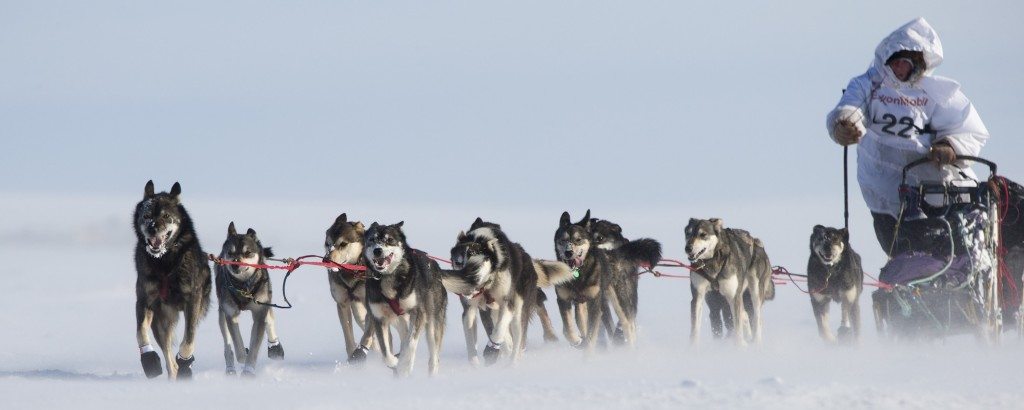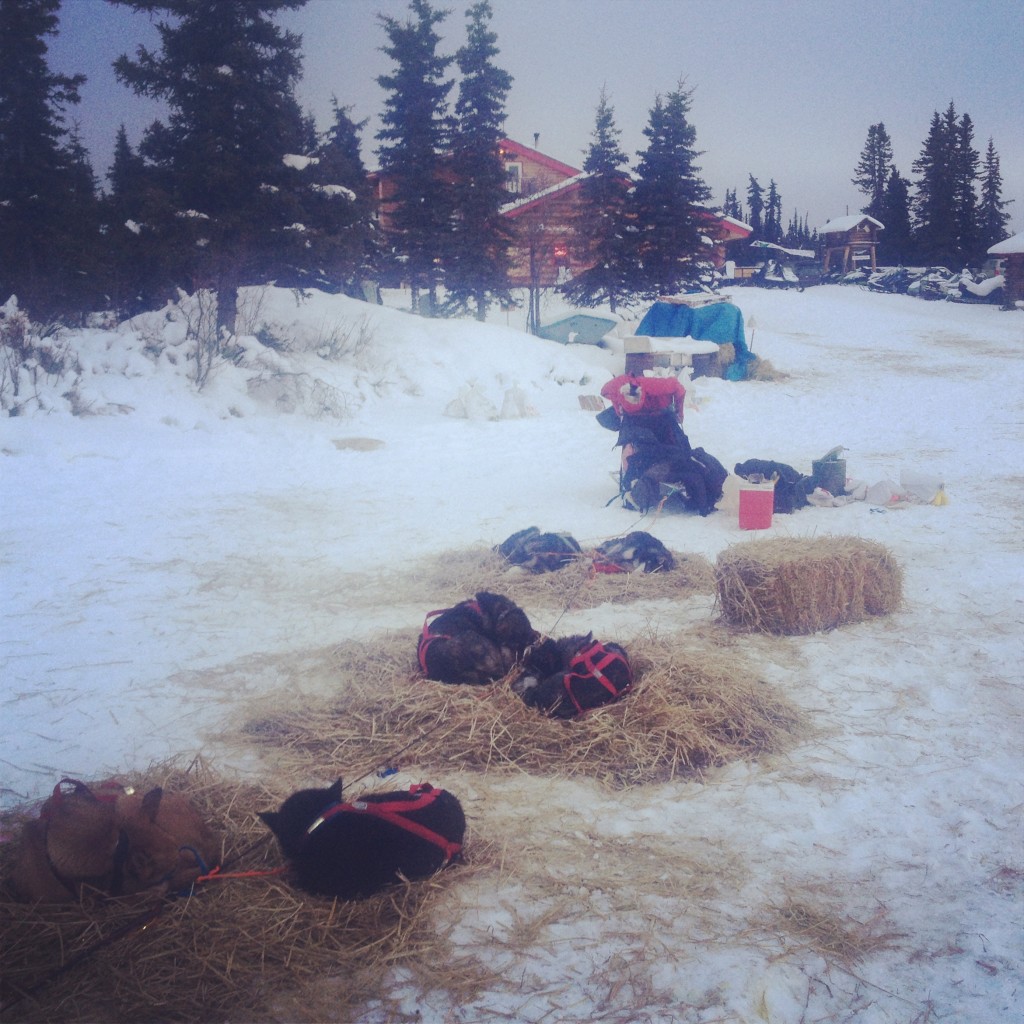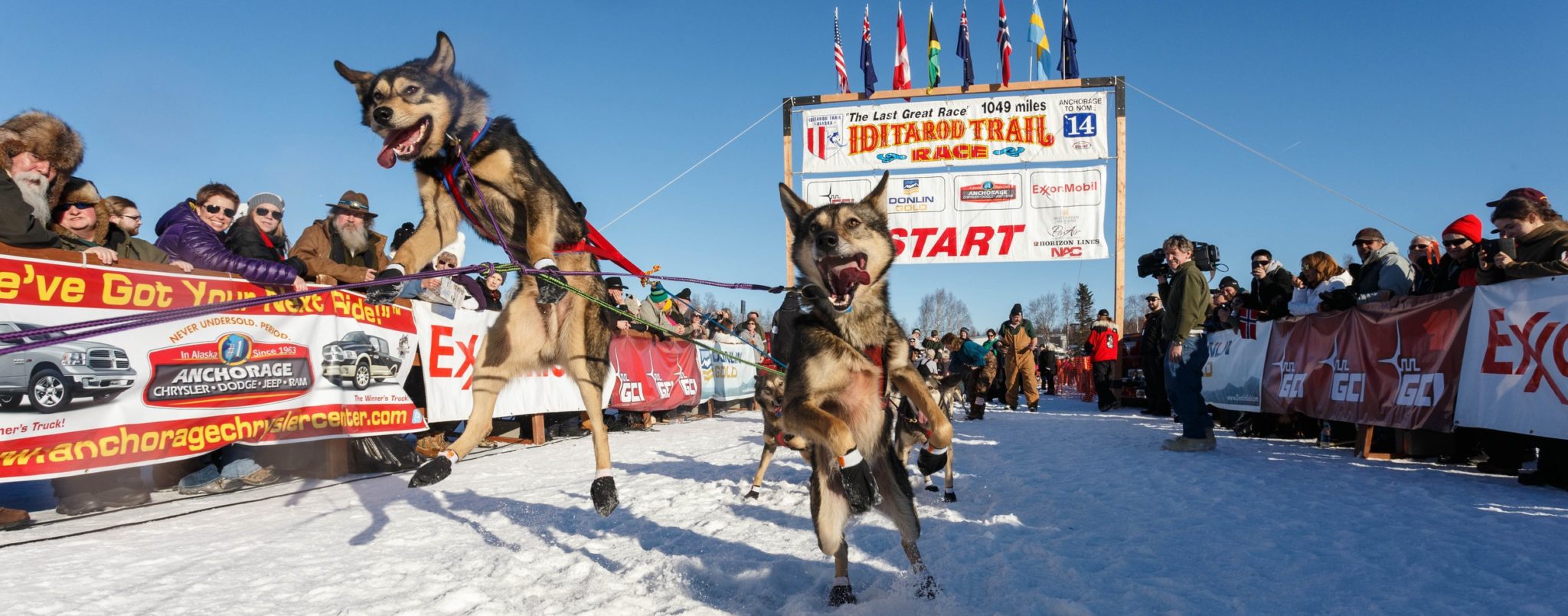What Is The Iditarod Sled Dog Race
Dog sledding or mushing is one of the more interesting, albeit unique, sports to follow during the winter months. Mushing has been part of Alaskan heritage for thousands of years shaping the way man tamed the arctic. With the advent of snowmachines and bush planes, many thought the era of the sled dog was over but through events such as the Iditarod and other sled dog races, sled dogs have continued mushing on Alaskan trails.
No longer needed strictly for utilitarian purposes, sled dogs have evolved into incredible endurance athletes through carefully outlined breeding programs. Today’s racing huskies are – in general faster and leaner than their ancestors but the bond these dogs share with their musher is as deep as it’s ever been. Ultimately it is this deep-rooted connection to the dogs and to the land itself that dog sledding celebrates. While many think the sport is anachronistic, the sport provides a backdrop to highlight the remarkable achievements of dogs and the bonds we share with them. Dog mushing, whether done recreationally or at a competitive level, requires tremendous amounts of hard work and dedication.
This year our kennel has again chosen to focus on the Iditarod Sled Dog Race. While other races are important, especially as a testing ground and measuring stick for our teams, Iditarod is ultimately the most important race to us this season. Because of this, we will spend a good deal of time focusing on the Iditarod in this blog in the next few months leading up to the race.

So What Is The Iditarod Sled Dog Race
The Iditarod is a 1,000 mile long dog sled race currently run from Willow, Alaska to Nome, Alaska. The race first ran in 1973 as a way to help keep the tradition of dogsledding alive. Iditarod succeeded. Today, the Iditarod boasts an average of 70 entrants, has a loyal following of fans, and has become Alaska’s premier sporting event, boasting fans from all over the globe.
About The Dogs That Compete In Iditarod
The dogs that race the Iditarod are primarily Alaskan Huskies, although teams of Siberian Huskies also frequent the race. To learn more about these different types of sled dogs, check out our earlier post What Is A Sled Dog.
How Many Dogs Do You Start Iditarod With
Today mushers can start Iditarod with 16 dogs and almost every musher chooses to do so. Although historically, mushers used to be able to take more dogs in 1996 the Iditarod Trail Committee limited the teams to 16 dogs. Prior to that mushers could race up to 20 dogs. During the first years of Iditarod, there actually was no limit on the number of dogs a musher could drive. We think 16 is a good limit because that provides plenty of power and gives mushers a great deal of depth to work with. 16 dogs, believe it or not, can pull a truck — so imagine how much power they have when they are h
How Many Dogs Do You Finish With?
Although mushers start with 16 dogs, it is quite rare to see them finish with all 16 of their dogs. Mushers are able to drop dogs during Iditarod at any checkpoint. The dogs will then be left with vets and volunteers while their musher continues on down the trail. Dogs are dropped during a race for a plethora of reasons but the main reasons are: a team can only travel as fast as the slowest dog, the dog gets sick, the dog gets injured or the dog is a female coming into heat. We’ll talk more about dropping dogs and the reason a musher may do it in greater depth in the weeks to come.
Checkpoints
Mushers and their teams do not have to start the race with all their gear. Gear is sent out along the trail to established places, generally bush villages, called checkpoints. These resupply stations allow mushers to run a dog bred more for endurance rather than for pulling large, heavy loads. Although mushers are not required to rest in checkpoints (except during mandatory rests) many of them opt to do so. Checkpoints provide many amenities such as hot water, microwaves, and beds for the mushers that sleeping on the open trail would not. Because of this, they are often swarming with activity.

Drop Bags
We have to prepare our gear for the race weeks in advance so it can be shipped out along the trail by the Iditarod Air Force — a volunteer crew of pilots who help fly all our stuff out along the trail. Our gear is sent out in what we call drop bags. Each drop bag weighs no more than 50lbs. Mushers can send anywhere from 1-3 bags to each checkpoint.
Straw & Heet
Straw and Heet are made available to mushers in each checkpoint. Each musher generally receives 1 bale of straw to use for bedding their dogs down. Resting dogs on straw gets them up off the snow and helps keep them warm.

Heet is used as a fuel out along the trail. Mushers use heet to melt snow and heat water for their dogs so that they can be given a warm meal along the trail. It is also carried in a mushers sled in case of emergency: mushers may need to prepare a meal along the way that they hadn’t planned or may need fire starter to help get them warm.
Mandatory Rest
Iditarod currently has 40 hours of mandatory rest built in to it. This by no means accounts for all the rest mushers must take: it simply provides a loose framework. The 40 hours of rest is broken up into 3 rests: a 24-hour layover to be taken anywhere on the trail, an 8-hour layover to be taken at any checkpoint on the Yukon river and an 8-hour layover at White Mountain, 77 miles from the finish line in Nome.
It is the structure of the rest that ultimately makes Iditarod such an interesting event when compared to other dog sled races. Because so little of the rest a dog team will end up taking in Iditarod is structured in “mandatory hours,” how and where rest is taken on the trail is not just part of an Iditarod strategy, it is the strategy.
While there are people who would prefer to see more rest built in to the race, we ultimately think that 40 hours is sufficient. Mushers know how to run their teams. If more mandatory layovers were added, rather than encourage rest it would encourage mushers to push their dogs harder until that next mandatory resting point. By giving mushers more flexibility in structuring their rest, Iditarod allows mushers to cater to the athletic style of the team.

Iditarod and the Two Race Routes
The Iditarod originally had only one race route, what is now the northern route, but in 1977 a decision was made by the race committee to establish a second route, now the southern route. The two routes only change the middle portion of the race, about 300 miles worth of trail. The northern route is now run during the even numbered years and the southern route is run on odd years. The decision for alternating routes helped include more bush villages and also helped eliminate the stress on villages by making it any every-other year occurrence. Preparing for the race, for all involved, takes a tremendous work and doing this helped relieve a great deal of stress on smaller interior villages
The Northern Route
The Iditarod Northern Route is run during even numbered years. It is widely considered by mushers to be the easier of the two routes because as mushers travel up the Yukon River they primarily have the wind at their backs. Additionally, the Northern Route travels through several bush villages: the trail is well maintained throughout the year and so by the time Iditarod comes around there is a nice base.
The Southern Route
Run only on odd-years, the Southern route is generally considered by mushers to be the more difficult of the two routes. The Southern Route goes through many “ghost villages,” such as the Iditarod Checkpoint, where the Iditarod Trail Committee has to send volunteers before the start of the race and put in these remote checkpoints.
Key Difference Between Northern & Southern routes
Because of the more remote nature of the Southern route, teams generally have to deal with tougher trail conditions. Unlike the more populated Northern Route, the Southern Route is not as maintained by local villages. Because of this, the first dog teams across it can (and often do) have a more difficult time and record slower speeds than teams who travel it later on in the race. This is due to the fact that the Souther Route trail does not have a good base. Put better, would you rather walk on a winter trail that people walked down all year (Northern Route) or on a trail that only one or two people have travelled over (Southern Route)?
While this is, perhaps, an over simplification it does illustrate one of the main difference between the Northern and the Southern routes. This also plays heavily into how mushers plan their 24-hour layover: many teams may choose to rest early so that other teams can break trail. After several teams have travelled the trail, cool temperatures will “harden” the trail, allowing faster travel times to be posted later on in the trace.
Another key difference between the two routes is the wind. Mushers generally say that on the Southern Route teams have to drive into the wind whereas on the Northern route the wind is at their back, helping to propel the teams along
Why You Should Follow Iditarod
Iditarod is one of the most interesting sporting events to follow along. The race showcases the bond between humans and dogs and tests the strength of that over one thousand miles. Mother nature always makes things interesting!
. There are so many variables as to what makes an individual musher and their team successful on any given year that the race generates lots of excitement. Following the race is fun due to live GPS tracking, video updates, as well as informative updates by families of the mushers. It is a sport that cherishes its fans and welcomes lots of interaction. Iditarod is a fun sport to follow. We hope you follow us in 2015!


